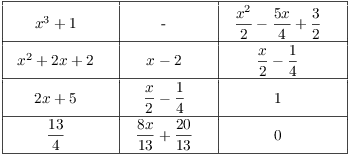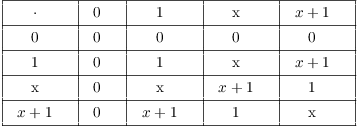In this section, I'll look at quotient rings of polynomial rings.
Let F be a field, and suppose ![]() .
. ![]() is the set of all
multiples (by polynomials) of
is the set of all
multiples (by polynomials) of ![]() , the (principal) ideal
generated by
, the (principal) ideal
generated by ![]() . When you form the
quotient ring
. When you form the
quotient ring ![]() , it is as if you've set multiples of
, it is as if you've set multiples of ![]() equal to 0.
equal to 0.
If ![]() , then
, then ![]() is the coset of
is the coset of ![]() represented by
represented by ![]() .
.
Define ![]() (
(![]() is congruent to
is congruent to ![]() mod
mod ![]() ) to mean that
) to mean that
![]()
In words, this means that ![]() and
and ![]() are congruent mod
are congruent mod ![]() if they differ by a multiple of
if they differ by a multiple of ![]() . In equation form, this says
. In equation form, this says ![]() for some
for some ![]() , or
, or ![]() for some
for some ![]() .
.
Lemma. Let R be a commutative ring, and
suppose ![]() . Then
. Then ![]() if and only
if
if and only
if ![]() .
.
Proof. Suppose ![]() . Then
. Then ![]() for some
for some ![]() . Hence,
. Hence,
![]()
Conversely, suppose ![]() . Then
. Then
![]()
Hence,
![]()
This means that ![]() .
.![]()
Depending on the situation, I may write ![]() or
or ![]() .
.
Example. ( A quotient ring of
the rational polynomial ring) Take ![]() in
in ![]() . Then two polynomials are
congruent mod
. Then two polynomials are
congruent mod ![]() if they differ by a
multiple of
if they differ by a
multiple of ![]() .
.
(a) Show that ![]() .
.
(b) Find a rational number r such that ![]() .
.
(c) Prove that ![]() .
.
(a)
![]()
(b) By the Remainder Theorem, when ![]() is divided by
is divided by ![]() , the remainder is
, the remainder is
![]()
Thus,
![]()
(c) I'll use the First Isomorphism Theorem. Define ![]() by
by
![]()
That is, ![]() evaluates a
polynomial at
evaluates a
polynomial at ![]() . Note that
. Note that
![]()
It follows that ![]() is a ring map.
is a ring map.
I claim that ![]() . Now
. Now ![]() if and only if
if and only if
![]()
That is, ![]() if and
only if 2 is a root of f. By the Root Theorem, this is equivalent to
if and
only if 2 is a root of f. By the Root Theorem, this is equivalent to
![]() , which is equivalent to
, which is equivalent to
![]() .
.
Next, I'll show that ![]() is surjective. Let
is surjective. Let ![]() . I can think of q as
a constant polynomial, and doing so,
. I can think of q as
a constant polynomial, and doing so, ![]() . Therefore,
. Therefore, ![]() is surjective.
is surjective.
Using these results,
![]()
The first equality follows from the fact that ![]() . The
isomorphism follows from the First Isomorphism Theorem. The second
equality follows from the fact that
. The
isomorphism follows from the First Isomorphism Theorem. The second
equality follows from the fact that ![]() is surjective.
is surjective.![]()
In the last example, ![]() was a field. The next result says that this is the
case exactly when
was a field. The next result says that this is the
case exactly when ![]() is irreducible.
is irreducible.
Theorem. ![]() is a field if and only if
is a field if and only if ![]() is irreducible.
is irreducible.
Proof. Since ![]() is a commutative ring with identity, so is
is a commutative ring with identity, so is
![]() .
.
Suppose ![]() is irreducible. I
need to show that
is irreducible. I
need to show that ![]() is a field. I need to show that nonzero elements are
invertible.
is a field. I need to show that nonzero elements are
invertible.
Take a nonzero element of ![]() --- say
--- say ![]() , for
, for ![]() . What does it mean for
. What does it mean for ![]() to be nonzero? It
means that
to be nonzero? It
means that ![]() , so
, so ![]() .
.
Now what is the greatest common divisor of ![]() and
and ![]() ? Well,
? Well, ![]() , but
, but ![]() is irreducible --- its only factors are
units and unit multiples of
is irreducible --- its only factors are
units and unit multiples of ![]() .
.
Suppose ![]() , where
, where ![]() and
and ![]() . Then
. Then ![]() , i.e.
, i.e. ![]() for some
for some ![]() . But then
. But then ![]() shows that
shows that ![]() , contrary to assumption.
, contrary to assumption.
The only other possibility is that ![]() , where
, where ![]() and
and ![]() . So I can find polynomials
. So I can find polynomials ![]() ,
, ![]() , such that
, such that
![]()
Then
![]()
Hence,

This shows that ![]() is the multiplicative inverse of
is the multiplicative inverse of ![]() . Therefore,
. Therefore, ![]() is invertible, and
is invertible, and
![]() is a field.
is a field.
Going the other way, suppose that ![]() is not irreducible. Then I can
find polynomials
is not irreducible. Then I can
find polynomials ![]() ,
, ![]() such that
such that ![]() , where
, where ![]() and
and ![]() both have smaller degree than
both have smaller degree than ![]() .
.
Because ![]() and
and ![]() have smaller degree than
have smaller degree than ![]() , they're not divisible by
, they're not divisible by ![]() . In particular,
. In particular,
![]()
But ![]() gives
gives
![]()
This shows that ![]() has zero divisors. Therefore, it's not an integral
domain --- and since fields are integral domains, it can't be a
field, either.
has zero divisors. Therefore, it's not an integral
domain --- and since fields are integral domains, it can't be a
field, either.![]()
Example. ( A quotient ring
which is not an integral domain) Prove that ![]() is not an integral domain by exhibiting a
pair of zero divisors.
is not an integral domain by exhibiting a
pair of zero divisors.
![]() and
and ![]() are zero
divisors, because
are zero
divisors, because
![]()
Example. ( A quotient ring
which is a field) (a) Show that ![]() is a field.
is a field.
(b) Find the inverse of ![]() in
in ![]() .
.
(a) Since ![]() for all
for all ![]() , it follows that
, it follows that ![]() has no rational roots. Hence, it's
irreducible, and the quotient ring is a field.
has no rational roots. Hence, it's
irreducible, and the quotient ring is a field.![]()
(b) Apply the Extended Euclidean algorithm to ![]() and
and ![]() :
:

Therefore,
![]()
Hence,
![]()
Reducing mod ![]() , I get
, I get

Thus, ![]() is the inverse of
is the inverse of ![]() .
.![]()
Example. ( A field with 4
elements) (a) Prove that ![]() is a field.
is a field.
(b) Find ![]() so that
so that
![]()
(c) Construct addition and multiplication tables for ![]() .
.
(a) Let ![]() . Then
. Then
![]() and
and ![]() . Since f has no roots in
. Since f has no roots in ![]() , it's irreducible. Hence,
, it's irreducible. Hence, ![]() is a field.
is a field.![]()
(b) By the Division Algorithm,
![]()
This equation says that ![]() and x differ by a multiple of
and x differ by a multiple of ![]() , so they represent the same coset
mod
, so they represent the same coset
mod ![]() .
.
Therefore,
![]()
(c) By the Division Algorithm, if ![]() , then
, then
![]()
There are two possibilities for a and two for b, a total of 4. It
follows that ![]() is a field with 4 elements. The elements
are
is a field with 4 elements. The elements
are
![]()
Here are the addition and multiplication tables for ![]() :
:


The addition table is fairly easy to understand: For example, ![]() , because
, because ![]() .
.
For the multiplication table, take ![]() as an example.
as an example. ![]() ; I apply the Division
Algorithm to get
; I apply the Division
Algorithm to get
![]()
So ![]() .
.
Alternatively, you can use the fact that in the quotient ring ![]() (omitting the coset notation),
so
(omitting the coset notation),
so ![]() (remember that
(remember that ![]() in
in ![]() ).
).![]()
Remark. In the same way, you can construct a
field of order ![]() for any prime n and
any
for any prime n and
any ![]() . Just take
. Just take ![]() and form the quotient ring
and form the quotient ring ![]() , where
, where ![]() is an irreducible polynomial of degree n.
is an irreducible polynomial of degree n.
Example. ( Computations in a
quotient ring) (a) Show that ![]() is a field.
is a field.
(b) How many elements are there in ![]() ?
?
(c) Compute
![]()
Express your answer in the form ![]() , where
, where ![]() .
.
(d) Find ![]() .
.
(a) ![]() has no roots in
has no roots in ![]() :
:

Since ![]() is a cubic, it follows
that it's irreducible. Hence,
is a cubic, it follows
that it's irreducible. Hence, ![]() is a field.
is a field.![]()
(b) By the Division Algorithm, every element of ![]() can be written in the form
can be written in the form
![]()
There are 3 choices each for a, b, and c. Therefore, ![]() has
has ![]() elements.
elements.![]()
(c)
![]()
By the Division Algorithm,
![]()
Therefore,
![]()
(d) Apply the Extended Euclidean algorithm:

![]()
Therefore,
![]()
Hence,
![]()
Copyright 2020 by Bruce Ikenaga